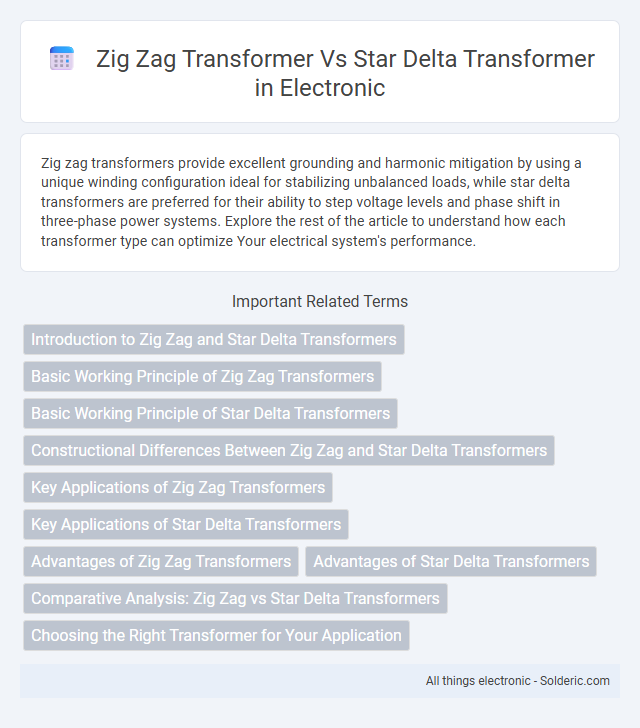Zig zag transformers provide excellent grounding and harmonic mitigation by using a unique winding configuration ideal for stabilizing unbalanced loads, while star delta transformers are preferred for their ability to step voltage levels and phase shift in three-phase power systems. Explore the rest of the article to understand how each transformer type can optimize Your electrical system's performance.
Comparison Table
| Feature | Zig Zag Transformer | Star Delta Transformer |
|---|---|---|
| Connection Type | Zig Zag winding | Primary: Star (Y), Secondary: Delta (D) |
| Purpose | Neutral grounding, harmonic reduction | Phase shift, supplying three-phase loads |
| Harmonic Suppression | Effective in reducing triplen harmonics | Moderate harmonic reduction via delta winding |
| Neutral Availability | Provides a solid neutral point | Neutral available only on star side |
| Phase Shift | No phase shift between primary and secondary | Typical 30deg phase shift |
| Applications | Grounding, harmonic mitigation in industrial systems | Distribution transformers, motor starting |
| Cost | Higher due to complex winding | Generally lower and simpler design |
Introduction to Zig Zag and Star Delta Transformers
Zig Zag transformers utilize interconnected windings to provide neutral grounding and reduce harmonics, making them ideal for systems requiring stable neutral points and minimal harmonic distortion. Star Delta transformers feature a star-connected primary winding and delta-connected secondary winding, allowing for voltage transformation with phase shifting to improve power system balance and reduce transformer size. Both transformers serve distinct purposes in electrical distribution, with Zig Zag transformers primarily used for grounding and harmonic mitigation, while Star Delta configurations focus on voltage conversion and phase displacement.
Basic Working Principle of Zig Zag Transformers
Zig zag transformers operate by connecting each phase winding in a zigzag manner to provide phase shifting and neutral grounding, effectively reducing harmonic distortions. They are designed to handle unbalanced loads and suppress triplen harmonics by creating a stable neutral point. This configuration enhances system stability and improves power quality in industrial and commercial electrical networks.
Basic Working Principle of Star Delta Transformers
Star delta transformers operate by connecting the primary winding in a star (Y) configuration and the secondary winding in a delta (D) configuration, enabling voltage transformation with phase shift and fault tolerance. The star connection on the primary side provides a neutral point and reduces phase voltage, while the delta connection on the secondary side helps in circulating third harmonic currents and balancing load. This configuration is widely used in three-phase power systems to supply balanced and stable voltages, minimize harmonics, and facilitate starting of polyphase motors.
Constructional Differences Between Zig Zag and Star Delta Transformers
Zig zag transformers consist of each phase winding split into two halves, connected in a zig zag pattern to provide phase displacement and reduce harmonic currents. Star delta transformers have a primary winding connected in a star (Y) configuration with a neutral point and a secondary winding connected in a delta (D) configuration to balance load and facilitate phase shifting. The constructional arrangement in zig zag transformers emphasizes harmonic suppression and grounding, while star delta transformers focus on voltage transformation and phase displacement for motor starting and power distribution.
Key Applications of Zig Zag Transformers
Zig zag transformers are primarily used for grounding purposes in power distribution systems, enabling effective neutral earthing and minimizing zero-sequence currents. They are ideal in applications requiring harmonic mitigation, such as in industrial facilities with nonlinear loads to reduce triplen harmonics and improve power quality. Zig zag transformers also serve well in unbalanced load conditions, providing stable neutral points and enhancing system reliability.
Key Applications of Star Delta Transformers
Star delta transformers are primarily used in applications requiring a reduction of starting current in induction motors and other heavy machinery. Their configuration enables a smooth transition to full load, minimizing electrical stress and preventing voltage dips in industrial power systems. You will often find star delta transformers in manufacturing plants, pumps, compressors, and HVAC systems due to their effectiveness in managing inrush current and improving motor longevity.
Advantages of Zig Zag Transformers
Zig Zag transformers provide superior grounding capabilities by effectively neutralizing unbalanced loads and minimizing zero-sequence currents, which enhances system stability in distribution networks. Their design facilitates better harmonic suppression and reduces the risk of resonance, improving power quality compared to star delta transformers. Zig Zag transformers also offer compactness and cost-efficiency in grounding applications, making them ideal for industrial and utility systems requiring reliable fault protection and load balance.
Advantages of Star Delta Transformers
Star delta transformers offer significant advantages including reduced starting current and smooth motor starting, which protects equipment and extends lifespan. Their ability to provide multiple voltage levels enhances compatibility with various electrical systems, improving efficiency and reliability. You benefit from cost-effective design and easy fault detection, making star delta transformers ideal for industrial applications.
Comparative Analysis: Zig Zag vs Star Delta Transformers
Zig zag transformers provide superior grounding capabilities and harmonic mitigation compared to star delta transformers, making them ideal for neutral grounding and suppression of triplen harmonics. Star delta transformers excel in phase shifting applications and fault isolation with simpler construction and lower cost, but they lack the robust neutral grounding feature inherent in zig zag configurations. The choice between zig zag and star delta transformers depends on system requirements for load balancing, harmonic control, and grounding effectiveness.
Choosing the Right Transformer for Your Application
Choosing the right transformer for your application depends on load type and grounding requirements; zig zag transformers provide excellent grounding and harmonic mitigation, making them ideal for unbalanced loads and sensitive equipment. Star delta transformers offer efficient voltage transformation and are commonly used for three-phase motor connections, ensuring smooth starting and reducing phase voltage. Your choice should align with system stability needs and specific electrical characteristics to optimize performance and safety.
zig zag transformer vs star delta transformer Infographic

 solderic.com
solderic.com